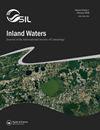Effects of grazing on taxonomic and functional diversity of benthic macroinvertebrates of six tributary streams of the eastern shore of Lake Hövsgöl, Mongolia
IF 2.3
3区 环境科学与生态学
Q1 LIMNOLOGY
引用次数: 1
Abstract
ABSTRACT Overgrazing is one of the major land-use impacts in Mongolia leading to habitat degradation and subsequent impairment of biological diversity. This study examined macroinvertebrate diversity among sites with different grazing intensities in Hövsgöl, Mongolia, to test whether the taxonomic and functional structure of the macroinvertebrate community differs among streams with different grazing intensity. The 14 551 total identified specimens comprised 78 genera in 27 macroinvertebrate families from the 6 study streams. Exponential Shannon index and weighted functional diversity were significantly higher in low grazing sites than in moderate and high grazing sites; no significant difference was found between moderate to high grazing intensity. Macroinvertebrate community composition was not significantly different between low and moderate or low and high grazing intensity sites. SIMPER analysis revealed the taxon with the highest contribution to dissimilarity among the levels of grazing. Thirteen trait categories from 8 traits differed significantly between sites with varying grazing pressure. The community-weighted means for 4 of these traits were filtered by high grazing intensity: dissemination, resistant form, current velocity, and saprobity. Although the other 4 traits differed significantly, they did not respond directly to grazing intensity. Further knowledge of traits, especially regarding physiological capabilities, is needed to better understand macroinvertebrate/environment relationships, but overall, these findings suggest that macroinvertebrate diversity components were affected by grazing.放牧对蒙古Hövsgöl湖东岸六条支流底栖大型无脊椎动物分类和功能多样性的影响
摘要过度放牧是蒙古国土地利用的主要影响之一,导致栖息地退化,进而损害生物多样性。本研究调查了蒙古Hövsgöl不同放牧强度地点的大型无脊椎动物多样性,以测试不同放牧强度溪流的大型无脊椎动物群落的分类和功能结构是否不同。14 551个已鉴定标本,包括来自6条研究溪流的27个大型无脊椎动物科的78属。指数香农指数和加权功能多样性在低放牧地显著高于中高放牧地;中度至高度放牧强度之间无显著差异。大型无脊椎动物群落组成在低强度和中等强度或低强度和高强度放牧地点之间没有显著差异。SIMPER分析揭示了对不同放牧水平差异贡献最大的分类单元。8个性状中的13个性状类别在不同放牧压力的地点之间存在显著差异。其中4个性状的群落加权平均值是通过高放牧强度过滤的:传播性、抗性形式、流速和腐性。尽管其他4个性状差异显著,但它们对放牧强度没有直接反应。需要进一步了解性状,特别是生理能力,才能更好地理解大型无脊椎动物与环境的关系,但总的来说,这些发现表明大型无脊椎动物的多样性成分受到放牧的影响。
本文章由计算机程序翻译,如有差异,请以英文原文为准。
求助全文
约1分钟内获得全文
求助全文
来源期刊

Inland Waters
LIMNOLOGY-MARINE & FRESHWATER BIOLOGY
CiteScore
6.10
自引率
9.70%
发文量
34
审稿时长
>12 weeks
期刊介绍:
Inland Waters is the peer-reviewed, scholarly outlet for original papers that advance science within the framework of the International Society of Limnology (SIL). The journal promotes understanding of inland aquatic ecosystems and their management. Subject matter parallels the content of SIL Congresses, and submissions based on presentations are encouraged.
All aspects of physical, chemical, and biological limnology are appropriate, as are papers on applied and regional limnology. The journal also aims to publish articles resulting from plenary lectures presented at SIL Congresses and occasional synthesis articles, as well as issues dedicated to a particular theme, specific water body, or aquatic ecosystem in a geographical area. Publication in the journal is not restricted to SIL members.
 求助内容:
求助内容: 应助结果提醒方式:
应助结果提醒方式:


